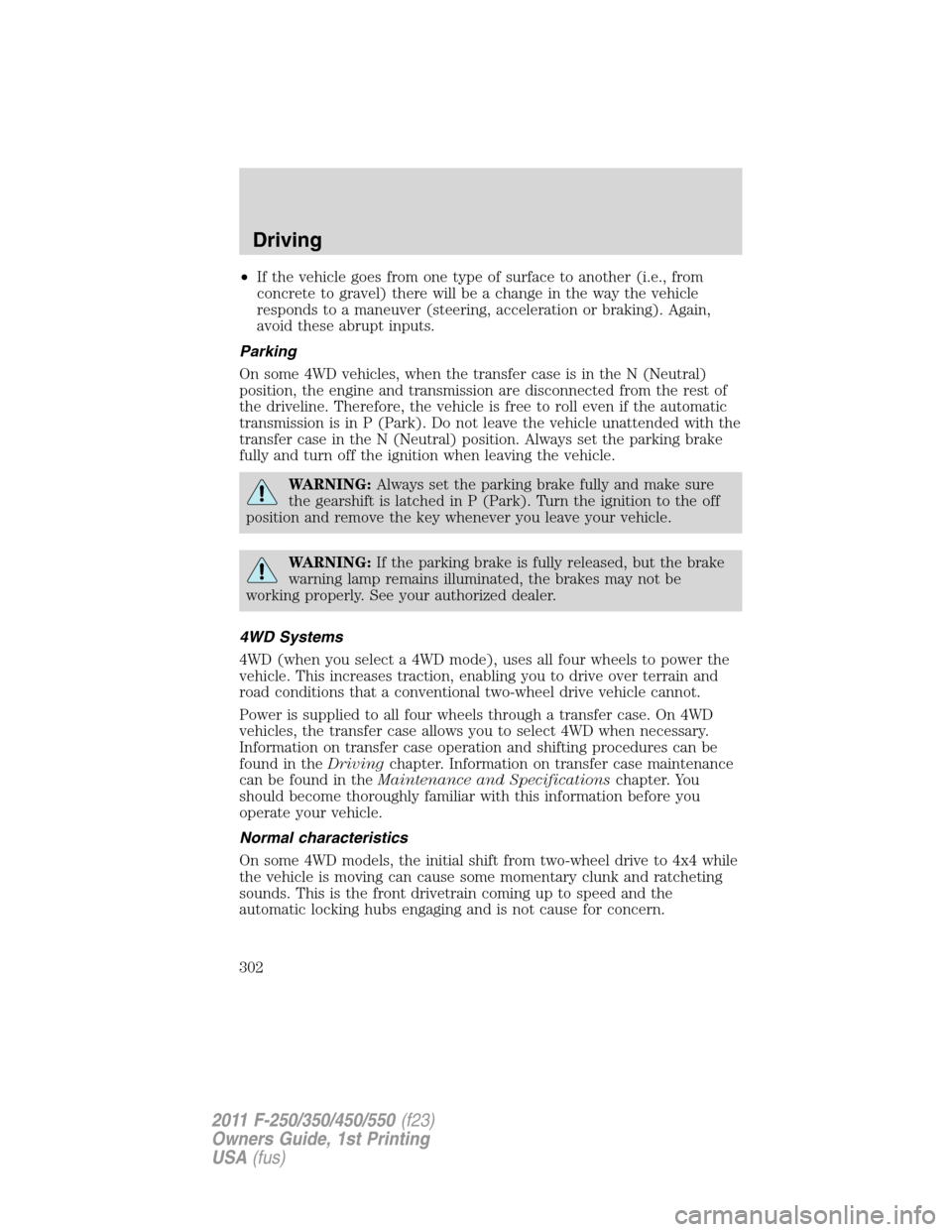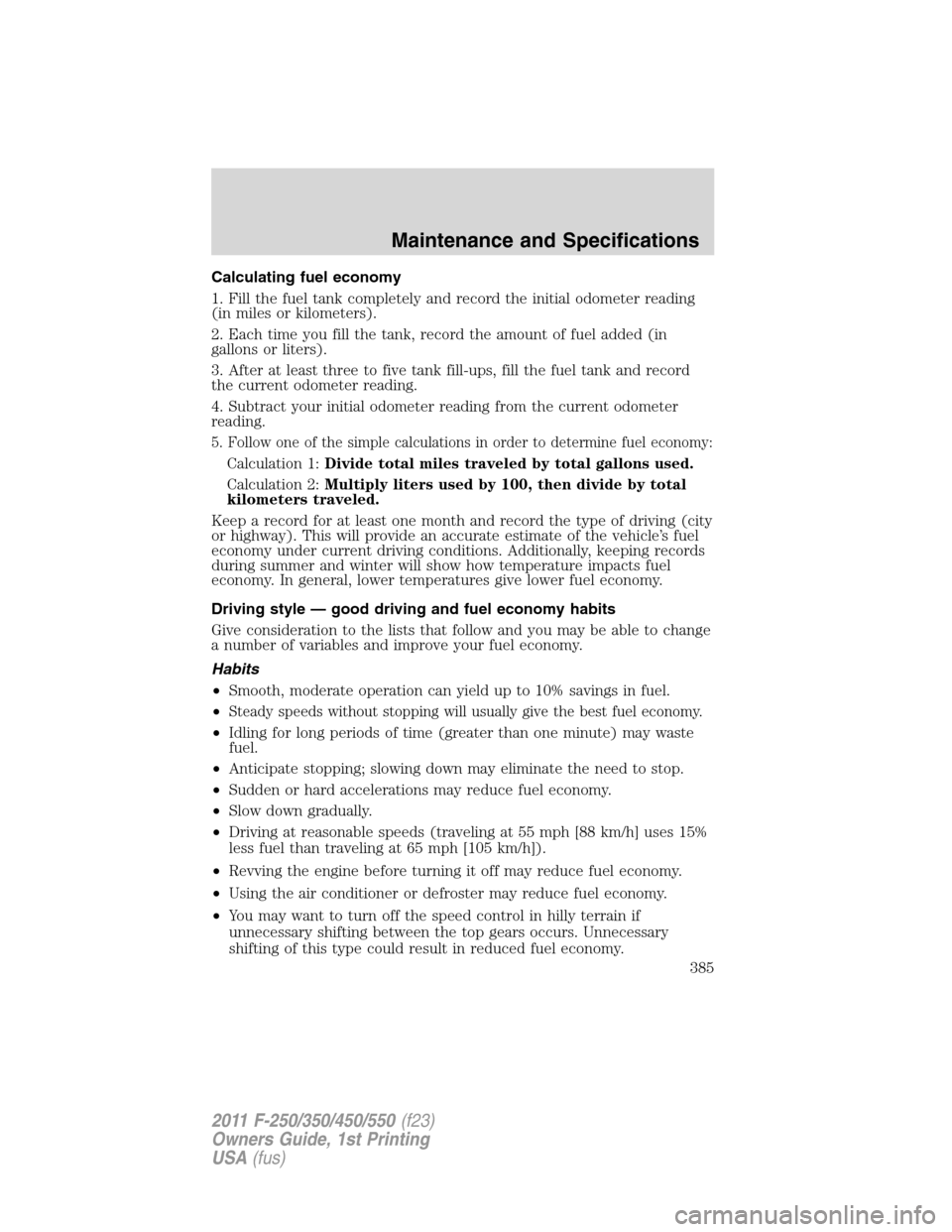2011 FORD SUPER DUTY ECO mode
[x] Cancel search: ECO modePage 302 of 441

•If the vehicle goes from one type of surface to another (i.e., from
concrete to gravel) there will be a change in the way the vehicle
responds to a maneuver (steering, acceleration or braking). Again,
avoid these abrupt inputs.
Parking
On some 4WD vehicles, when the transfer case is in the N (Neutral)
position, the engine and transmission are disconnected from the rest of
the driveline. Therefore, the vehicle is free to roll even if the automatic
transmission is in P (Park). Do not leave the vehicle unattended with the
transfer case in the N (Neutral) position. Always set the parking brake
fully and turn off the ignition when leaving the vehicle.
WARNING:Always set the parking brake fully and make sure
the gearshift is latched in P (Park). Turn the ignition to the off
position and remove the key whenever you leave your vehicle.
WARNING:If the parking brake is fully released, but the brake
warning lamp remains illuminated, the brakes may not be
working properly. See your authorized dealer.
4WD Systems
4WD (when you select a 4WD mode), uses all four wheels to power the
vehicle. This increases traction, enabling you to drive over terrain and
road conditions that a conventional two-wheel drive vehicle cannot.
Power is supplied to all four wheels through a transfer case. On 4WD
vehicles, the transfer case allows you to select 4WD when necessary.
Information on transfer case operation and shifting procedures can be
found in theDrivingchapter. Information on transfer case maintenance
can be found in theMaintenance and Specificationschapter. You
should become thoroughly familiar with this information before you
operate your vehicle.
Normal characteristics
On some 4WD models, the initial shift from two-wheel drive to 4x4 while
the vehicle is moving can cause some momentary clunk and ratcheting
sounds. This is the front drivetrain coming up to speed and the
automatic locking hubs engaging and is not cause for concern.
Driving
302
2011 F-250/350/450/550(f23)
Owners Guide, 1st Printing
USA(fus)
Page 313 of 441

FUEL PUMP SHUT-OFF
In the event of a moderate to severe collision, this vehicle is equipped
with a fuel pump shut-off feature that stops the flow of fuel to the
engine. Not every impact will cause a shut-off.
Should your vehicle shut off after a collision due to this feature, you may
restart your vehicle by doing the following:
1. Turn the ignition switch to the off position.
2. Turn the ignition switch to the on position.
In some instances the vehicle may not restart the first time you try to
restart and may take one additional attempt.
WARNING:Failure to inspect and if necessary repair fuel leaks
after a collision may increase the risk of fire and serious injury.
Ford Motor Company recommends that the fuel system be inspected
by an authorized dealer after any collision.
FUSES AND RELAYS
Fuses
If electrical components in the
vehicle are not working, a fuse may
have blown. Blown fuses are
identified by a broken wire within
the fuse. Check the appropriate
fuses before replacing any electrical
components.
Note:Always replace a fuse with one that has the specified amperage
rating. Using a fuse with a higher amperage rating can cause severe wire
damage and could start a fire.
15
Roadside Emergencies
313
2011 F-250/350/450/550(f23)
Owners Guide, 1st Printing
USA(fus)
Page 325 of 441

•Ground clearance and parking at curbs
•Winter weather driving capability
•Wet weather driving capability
It is not recommended that the vehicle be operated in 4WD modes with
a temporary emergency spare tire. If 4WD operation is necessary, do not
operate above speeds of 10 mph (16 km/h) or for distances above
50 miles (80 km).
3.Full-size dissimilar spare without label on wheel
When driving with the full-size dissimilar spare tire/wheel,do not:
•Exceed 70 mph (113 km/h)
•Use more than one dissimilar spare tire/wheel at a time
•Use commercial car washing equipment
•Use snow chains on the end of the vehicle with the dissimilar spare
tire/wheel
The usage of a full-size dissimilar spare tire/wheel can lead to
impairment of the following:
•Handling, stability and braking performance
•Comfort and noise
•Ground clearance and parking at curbs
•Winter weather driving capability
•Wet weather driving capability
•All-Wheel driving capability (if applicable)
•Load leveling adjustment (if applicable)
When driving with the full-size dissimilar spare tire/wheel additional
caution should be given to:
•Towing a trailer
•Driving vehicles equipped with a camper body
•Driving vehicles with a load on the cargo rack
Drive cautiously when using a full-size dissimilar spare tire/wheel and
seek service as soon as possible.
Roadside Emergencies
325
2011 F-250/350/450/550(f23)
Owners Guide, 1st Printing
USA(fus)
Page 385 of 441

Calculating fuel economy
1. Fill the fuel tank completely and record the initial odometer reading
(in miles or kilometers).
2. Each time you fill the tank, record the amount of fuel added (in
gallons or liters).
3. After at least three to five tank fill-ups, fill the fuel tank and record
the current odometer reading.
4. Subtract your initial odometer reading from the current odometer
reading.
5. Follow one of the simple calculations in order to determine fuel economy:
Calculation 1:Divide total miles traveled by total gallons used.
Calculation 2:Multiply liters used by 100, then divide by total
kilometers traveled.
Keep a record for at least one month and record the type of driving (city
or highway). This will provide an accurate estimate of the vehicle’s fuel
economy under current driving conditions. Additionally, keeping records
during summer and winter will show how temperature impacts fuel
economy. In general, lower temperatures give lower fuel economy.
Driving style — good driving and fuel economy habits
Give consideration to the lists that follow and you may be able to change
a number of variables and improve your fuel economy.
Habits
•Smooth, moderate operation can yield up to 10% savings in fuel.
•
Steady speeds without stopping will usually give the best fuel economy.
•Idling for long periods of time (greater than one minute) may waste
fuel.
•Anticipate stopping; slowing down may eliminate the need to stop.
•Sudden or hard accelerations may reduce fuel economy.
•Slow down gradually.
•Driving at reasonable speeds (traveling at 55 mph [88 km/h] uses 15%
less fuel than traveling at 65 mph [105 km/h]).
•Revving the engine before turning it off may reduce fuel economy.
•Using the air conditioner or defroster may reduce fuel economy.
•You may want to turn off the speed control in hilly terrain if
unnecessary shifting between the top gears occurs. Unnecessary
shifting of this type could result in reduced fuel economy.
Maintenance and Specifications
385
2011 F-250/350/450/550(f23)
Owners Guide, 1st Printing
USA(fus)
Page 409 of 441

Lifestyle
•Ash cup / smoker’s package•Racks and carriers*
•Bedliners and bedmats•Truck bed camping tent*
•Subwoofer*•Sportliner cargo liner*
•Towing mirrors•Trailer hitch balls*
•Navigation*•Rear seat entertainment*
•Tonneau covers*•Trailer hitches, wiring harnesses
and accessories
Peace of mind
•Keyless entry keypad•Back up camera*
•Remote start•Back up alarm*
•Vehicle security systems•Cable lock*
•Wheel locks•Bed hooks*
•Vehicle tracking and recovery*•Tool/Cargo boxes*
•Protective seat covers*•Windshield wiper shaker*
•Bumper and hitch mounted parking sensors*
Not all accessories are available for all models.
*Ford Licensed Accessories (FLA) are warranted by the accessory
manufacturer’s warranty. Ford Licensed Accessories are fully designed
and developed by the accessory manufacturer and have not been
designed or tested to Ford Motor Company engineering requirements.
Contact your Ford dealer for details regarding the manufacturer’s limited
warranty and/or a copy of the FLA product limited warranty offered by
the accessory manufacturer.
For maximum vehicle performance, keep the following information in
mind when adding accessories or equipment to your vehicle:
•When adding accessories, equipment, passengers and luggage to your
vehicle, do not exceed the total weight capacity of the vehicle or of
the front or rear axle (GVWR or GAWR as indicated on the Safety
Compliance Certification Label). Consult your authorized dealer for
specific weight information.
•The Federal Communications Commission (FCC) and Canadian Radio
Telecommunications Commission (CRTC) regulate the use of mobile
communications systems — such as two-way radios, telephones and
theft alarms - that are equipped with radio transmitters. Any such
equipment installed in your vehicle should comply with FCC or CRTC
regulations and should be installed only by your authorized dealer.
Accessories
409
2011 F-250/350/450/550(f23)
Owners Guide, 1st Printing
USA(fus)
Page 437 of 441

refill capacities ........................400
service points ..................362–364
Engine block heater .................263
Engine oil ..................................366
checking and adding ..............366
dipstick ....................................366
filter, specifications ........367, 399
recommendations ...................367
refill capacities ........................400
Event data recording ....................8
Exhaust fumes ..........................262
F
Fail safe cooling ........................374
Fleet MyKey programming ......126
Flexible Fuel Vehicle
(FFV) .........................................377
Floor mats .................................120
Fluid capacities .........................400
Fog lamps ....................................87
Four-Wheel Drive vehicles .......293
driving off road .......................299
electronic shift ................294, 298
indicator light .........................295
lever operated shift ................295
manual locking hubs ..............293
preparing to drive your
vehicle .....................................278
Fuel ............................................377
calculating fuel
economy ............................25, 384
cap ...........................................380
capacity ...................................400
choosing the right fuel ...........381
detergent in fuel .....................383
filling your vehicle
with fuel ..................377, 380, 384filter, specifications ........377, 399
fuel pump shut-off ..................313
improving fuel economy ........384
octane rating ...................382, 404
quality ......................................382
running out of fuel .................383
safety information relating to
automotive fuels .....................377
Fuel - flex fuel vehicle
(FFV) .........................377, 381–382
Fuses ..................................313–314
G
Garage door opener ..................115
Gas cap (see Fuel cap) ............380
Gas mileage
(see Fuel economy) .................384
Gauges .........................................21
H
Hazard flashers .........................312
Headlamps ...................................86
aiming ..................................88–89
autolamp system .......................86
daytime running lights .............88
flash to pass ..............................87
high beam .................................87
replacing bulbs .........................92
turning on and off ....................86
Heating
heating and air conditioning
system .................................78, 81
Hill descent mode .....................275
Hill launch assist .......................287
Hood ..........................................362
Index
437
2011 F-250/350/450/550(f23)
Owners Guide, 1st Printing
USA(fus)